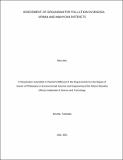Assessment of groundwater pollution in Singida urban and Manyoni districts
Abstract
The quality of groundwater in Tanzania has over the years remained poorly understood, hence
posing risks to human health and the environment. In this study, the quality of groundwater
sources used for drinking purpose in Singida Urban and Manyoni districts were investigated with
a view to explore how the end users could be safeguarded from water borne diseases. Water
samples from 30 boreholes and 28 shallow wells were randomly collected during dry and wet
seasons. Water quality assessments were conducted following recommended guidelines by
Tanzania Bureau of Standards (TBS) and international standards (WHO) for drinking water.
Twelve physicochemical parameters were assessed using standard methods for water and
wastewater from American Public and Health Association (APHA). Microbial water quality (TC,
FC, and E.coli) were examined using membrane filtration technique while toxic metals were
determined using Inductively Coupled Plasma Optical Emission Spectrometer. Nitrate source
identifications were done using Elemental Analyzer/ isotope ratio mass spectrometry techniques.
Results showed that shallow wells recorded significant higher turbidity (p<0.0001) compared to
boreholes. The water samples collected during wet season had significantly higher microbial
contamination compared to those collected during dry season. Additionally, the wells were
buckets are used to draw water had significantly higher TC, FC and E.coli (n=11, p≤ 0.01), also
wells without covers (n=15, p≤0.01) had significantly higher feacal coliform bacteria than those
which motor or hand pump were used in both seasons. Concentration of toxic metals was
significantly higher (p<0.05) during the dry season than in the wet season and 40- 66% of all
samples had an elevated level of Mn, Cr, Pb, and Al above the recommended standards by World
Health Organization (WHO) and Tanzania Bureau of Standards (TBS), hence unsafe for
drinking. Nitrate sources identification revealed that, most nitrate contamination were originated
from sewage effluents and/or organic wastes such as manure. The study recommends that water
from shallow wells should be treated either by boiling, chlorination, or use of low cost
technologies such as sand filter before consumption. In addition, the proper sitting of the wells
based on the recommended standards by TBS has to be enforced in order to prevent further
contamination from human activities.

